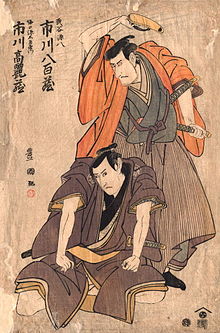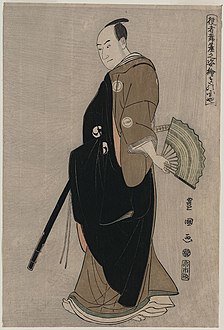
Utagawa Toyokuni (Japanese: 歌川豊国; 1769 in Edo – 24 February 1825 in Edo), also often referred to as Toyokuni I, to distinguish him from the members of his school who took over his gō (art-name) after he died, was a great master of ukiyo-e, known in particular for his kabuki actor prints. He was the second head of the renowned Utagawa school of Japanese woodblock artists, and was the artist who elevated it to the position of great fame and power it occupied for the rest of the nineteenth century.
Biography
He was born in Edo, the son of Kurahashi Gorobei, a carver of dolls and puppets, including replicas of kabuki actors. At around 14, Toyokuni was apprenticed to the first head of the Utagawa house, Utagawa Toyoharu, whom his father knew well and who lived nearby. One of his fellow pupils under Toyoharu was Toyohiro, whose pupil was the great landscape artist Hiroshige. In recognition of his artistic ability, Toyokuni later took the name Utagawa Toyokuni, following the common practice of using one syllable of his master's name.
Toyokuni seems not to have been an "intuitive genius" determined to forge a new path; rather, he seems to have studied intently those who came before him, particularly Utamaro, Chōbunsai Eishi and Eishōsai Chōki. and through a great deal of hard work produced first a mastery, and then a synthesis of their styles, to create a style of his own.
He was known mostly for his prints related to the kabuki theatre, in particular his yakusha-e actor portraits, a field which he took to new heights. He also, however, produced other genres such as musha-e warrior prints, shunga erotica, and most notably bijin-ga.


In his actor prints, like Sharaku, one sees the real subject; but his prints merely portrayed what he saw, unlike Sharaku who exaggerated those aspects he saw as the most key. It is said of Toyokuni's prints that they recreate exactly what one would see on stage; they show actors acting, not merely just pictures of actors. Together, these characteristics made Toyokuni's prints far more popular among theatre-goers than Sharaku's, although history has come to judge Sharaku the keener observer and greater artist.
His popularity and prolific output may in part have been his undoing, though. From 1803 through 1817, his work became more static, even as it became more popular. He continued to produce large quantities of prints, but the quality as a rule did not match that of his earlier days. Occasional prints from this period, however, show his old brilliance.
He died in Edo in 1825, surrounded by many of his pupils.
Names
Like most Edo period Japanese artists, Toyokuni was known by several names throughout his lifetime, some sequentially and some concurrently.
- Family name (姓 - sei): Kurahashi (倉橋)
- Childhood name (幼名 - yōmyō): Kumakichi (熊吉)
- Nickname (通称 - tsūshō): Kumaemon (熊右衛門)
- Art names (号 - gō): Utagawa Toyokuni (歌川豊国), Utagawa Ichiyōsai (歌川 一陽斎), Ichiyōsai Toyokuni (一陽斎 豊国)
- Posthumous Buddhist name (戒名 - kaimyō / 法名 - hōmyō): Tokumyōin Jissaireigō Shinji
In addition, the name 'Toyokuni' has been transcribed through several kanji character combinations, both by the artist himself and by those writing about him.
- Characters used to write Toyokuni: 豊国, 豊國, 豊圀, 豐國, 豐圀
Today, Toyokuni is almost universally written using the characters 豊国. Each of the other kanji are no longer in common usage.
Pupils

Toyokuni's two major pupils were the woodblock print masters Kunisada and Kuniyoshi, but he had a host of students in his school. Indeed, so powerful was the Utagawa school after Toyokuni's time that almost every Japanese print artist of note either had one of these two characters in his gō, or, like Yoshitoshi, was a student of one who did.
His gō, "Toyokuni", was initially used after his death by his son-in-law, Toyoshige, who is therefore known to us as Toyokuni II. Thereafter, it was handed down and used by each head of the Utagawa school in turn. Kunisada is thus also known as Toyokuni III.
Retrospective observations
Evaluations of him as an artist are somewhat mixed. Indeed, he himself is reported to have once said:
- "My pictures – they are merely something that I draw, and nothing more than that!"
The main criticisms of his works relate to his "predominantly imitative" style, and to the "marked decline" in the quality of works from later in his career. However, Toyokuni's style is admired for characteristics such as "decorative bombast", and "bold, taut designs". He is also credited with such innovations as diptych, triptych and polyptych formats, and with training future masters of ukiyo-e. His work captured the world around him, particularly the kabuki theatre, with great clarity, and his style was a step forward. In addition, it was commercially successful, and thus freed woodblock prints from many of the restrictive canons which had limited previous generations of artists.
Print series
Here is a very incomplete list of his print series, with dates:
- Views of Actors on Stage (ca. 1793)
- Sketches of Seven Elegant Paragons of Beauty (ca. 1800)
- Views of Elegant Geisha in Characteristic Poses (ca. 1801)
- Tomimoto the Geisha (ca. 1830-1844)
Collections and museums
Gallery
-
 The poetess Ono-no Komachi in the rain
The poetess Ono-no Komachi in the rain
-
 Kabuki actors, ca. 1800
Kabuki actors, ca. 1800
-
 Kinokuniya Sawamura Sojuro III as Ogishi Kurando, 1794
Kinokuniya Sawamura Sojuro III as Ogishi Kurando, 1794
See also
- List of Utagawa school members
- Ichikawa Omezō as a Pilgrim and Ichikawa Yaozō as a Samurai (Toyokuni I)
References
- Percival 1978, 30
- Chiappa 2013
- Percival 1978, 30
- Chiappa 2012
- Percival 1978, 30
- Newland 2005, 502
- Marks 2010, 96
- Tazawa 1981, 346
- Tazawa 1981, 346
- Chiappa 2013
- According to Marks, by the time of his death at age 57, Toyokuni had produced more than 90 print series, over 400 illustrated books, and several hundred single sheet prints. (2010, 96)
- Waterhouse 1975, 200
- Waterhouse 1975, 200
- Tazawa 1981, 347
- Tazawa 1981, 347
- Tazawa 1981, 347
- ULAN 2004
- Marks 2010, 96
- ULAN 2004
- Chiappa 2013
- From his accession to the name Toyokuni in 1844, Kunisada consistently signed his works Toyokuni II, refusing to accept the legitimacy of his predecessor, Toyokuni II. He is, however, always referred to as Toyokuni III (Marks 2010, 120).
- Newland 2005, 502
- Lane 1978, 151
- Waterhouse 1975, 200
- Lane 1978, 152
- Newland 2005, 502
- Percival 1978, 32
- Tazawa 1981, 346
Further reading
- Sadao Kikuchi, (translated Roy Andrew Miller), Utagawa Toyokuni (1769-1825) (Charles E. Tuttle, Rutland, 1959)
- Friedrich Succo, Utagawa Toyokuni und Seine Zeit (R. Piper, Munich, 1924)
- Chiappa, J. Noel. "Utagawa Toyokuni (1769–1825)". 2013. Accessed September 24, 2013.
- Lane, Richard. Images from the Floating World of the Japanese Print. New York: Konecky & Konecky, 1978.
- Marks, Andreas. Japanese Woodblock Prints: Artists, Publishers and Masterworks 1680–1900. Tokyo: Tuttle, 2010.
- Newland, Amy Reigle. Ed. Hotei Encyclopedia of Woodblock Prints, vol. 2., 2005.
- Percival, Robert. Ukiyo-e: Art for the People. Saint John, New Brunswick: MacMillan Press, 1978.
- Tazawa, Yutaka. Ed. Biographical Dictionary of Japanese Art. Tokyo: Kodansha, 1981.
- ULAN (Union List of Artist Names Online). "Utagawa Toyokuni". J. Paul Getty Trust. 2004. Accessed October 1, 2013.
- Waterhouse, David. Images of Eighteenth Century Japan: Ukiyo-e Prints from the Sir Edmund Walker Collection. Toronto: Royal Ontario Museum, 1975.
External links
[REDACTED] Media related to Utagawa Toyokuni at Wikimedia Commons
Categories: